.
.




Healing Clearly for "Her Universe to See All are Healed by her Devine Light"
and Gift .

*Note* All information below and outside the Brahma Satya Reiki
Website are for your learning there is no endorsement here for their inclusion.
"In the great teaching of the Vedas, there is no touch of sectarianism. It is of all ages, climes and nationalities and is the royal road for the attainment of the Great Knowledge."
- Thoreau(American Thinker)
In religion, India is the only millionaire .... The One land that all men desire to see and having seen once, by even a glimpse, would not give that glimpse for all the shows of all the rest of the globe combined."
- Mark Twain(American Author 1835-1910)
HINDUISM in a NUTSHELL
The salient features of Hinduism are as follows
1. SANATANA DHARMA
(Eternal Virtues )
The basic tenets of good conduct one should observe in day to day life and those evil tendencies one should avoid scrupulously to make life worthwhile both individually and socially is called the Sanatana Dharma. Hinduism is a positive vibrant religion showing how to live peacefully and die gracefully, if the time comes, when it comes and is definitely not fatalistic as some believe.
2. APAURUSHEYAM (Authorlessness)
Hinduism has no single founder or a single event which started the religion. A series of scriptural literature (Vedas) believed to have originated from what the Hindus call the 'Brahman' (in the neuter gender) but not created by him either. The 'Vedas' literally 'knowledge' is considered to exist permanently and after every deluge (Pralaya), 'Brahman' remembered the texts and taught them to the fourfaced Brahma and through him to succeeding generations through oral tradition - the 'Auditory' phenomenon.
Hinduism is thus a primordial religion.
3. AVATAR (Descent)
God can 'descend' and 'appear' in any form to show us imperfect beings how to achieve perfection!.
4. VIGRAHA ARADHANA
(Idol Worship)
God is Omnipresent. Any object in the manifest world is created, supported, directed and controlled by God. Mind cannot visualize God (and consequently worship) in abstraction or isolation. So, God can be worshiped in any form or material so created, supported, controlled and directed by God. Just as the Flag is a symbol of a nation, an idol for the Hindu is symbolic of God. In idol worship, it is the attitude that matters, the attitude of loving devotion (Bhakti), not the ritual as a ritual. Hindus worship God enshrined In the idol, not the idol itself As God.
5. KARMA
(Action and Result of action)
The 'Punya'( Spiritual merit) or 'Papa' (Sin) of every being accumulated by it in its previous births which incidentally may be innumerable, conditions its future. How one will be born, or will be happy or miserable depends on the effects of Karma or action performed during the present life: aninevitable cause and effect phenomenon.
6. PUNARJANMA
(Re-Incarnation or Transmigration of Souls)
Everything is transient, impermanent. God is the ONLY reality that is permanent and everlasting. Every soul in its evolution toward Godhood needs 'reincarnation' to expend all the 'good' and 'bad' accumulated in successive births. Only when the balance sheet shows a nil balance of both punya and papa can one reach Godhood. This is closely linked to Karma mentioned above.
7. PURUSHARTAS
(Objectives of life)
Long before others could even comprehend the purpose of life, Hinduism had not only identified the answers but had also classified them as Dharma (Virtue), Artha (Material prosperity), Kama (sensual pleasures) and Moksha ( Salvation ). The secondary objectives of Artha and Kama have been sandwiched between the primary objectives of Dharma and Moksha.
8. CHATUR VARNAS
(Caste System - aptitudes)
Human beings are classified into four different castes based on their basic aptitudes. The four castes are Brahmana (Priests), Kshatriya (warriors), Vysya (business people) and Sudra (service class). The caste system is a natural biological phenomenon which only Hinduism has recognized explicitly.
Caste system in one form or the other is implicitly practiced world over without such a 'label'.
9. CHATUR-ASHRAMAS
(Four stages of life)
As a means of fulfilling all individual duties, Hinduism proposes four stages (Ashramas) of life. The four stages of life are: Brahmacharya (Student), Grihasta (house-holder), Sanyasa (life of renunciate) and Vanaprastha (ascetic or hermi life in forest). The four stages are like th efour step ladder to liberation.
10. TRI-GUNAS
(Triple qualities)
Human psyche is governed by a mixture of qualities or attitudes called Satva (Serenity), Rajas (Vigor) and Tamas (lethargy). Promoting the first, regulating the second and eliminating the last would ensure proper evolution of the individual both mentally and physically. A dietary regimen is considered to be one important discipline to guarantee this evolution, the other being the control of the physical and mental reflexes.
11. TRI-GANAS
(Three groups)
The three ganas or groups of people are: Deva (Godly), Manushya (Human) and Rakshasa (Demonic). For example, Duryodhan can be looked upon as a Demonic-Rajasic-Kshatriya and Yudhistir as a Godly-Satvik-Kshatriya.
12. TRI-RUNAS
(Three Debts)
Three debts in one's life are to be fulfilled for an ideal life. The three debts are Deva Runa (debt to God), Pitru Runa (Debt to parents) and Rishi Runa (Debt to the learned -saints, sages and gurus). In present terms, these debts can be fulfilled by having a sense of service to the fellow beings (debt to God), raising a child (debt to parents) and learning the work of great souls (debt to the learned).
13. YOGA AND PRAPATTI
(Union and Surrender)
The ultimate objective of individual souls is to seek union with the Universal soul (God). This union is what the word 'Yoga' means. Hinduism considers several yogas including Raja yoga (Kingly union), Hata yoga (Forceful union), Karma yoga (union through action), Gnana yoga (union through Knowledge) and Bhakti yoga (union through devotion) and finally the direct and easiest means of Prapatti (Absolute surrender to God).
14. SAHYAM (Tolerance)
Hinduism believes that all religions are true - not as a matter of strategy but as an article of faith. Therefore, Hinduism does not encourage hate or distrust. Hinduism is intolerant of intolerance. Hinduism does not equate tolerance with inertia or apathy. Hinduism never deemed it as its mission to convert others to its opinions since what matters ultimately is conduct not creed. At best, Hinduism encourages conscience and adherence to truth. This characteristic distinguishes Hinduism as one directed towards an inner cohesion.
15. EKATVAM
(Unity in diversity)
No particular doctrine, dogma or practice is central to Hinduism. The extraordinary diversity of Hinduism is the result of prehistoric, historic and the contemporary situations. Evolution and assimilation of the Aryan religion not only with those of the native originals but also with every wave of new elements from far and wide in space and from time to time has produced an enormous variety of systems, beliefs and practices.
It is the Hindu self - awareness and self - identity that affirms Hinduism to be a single religious universe. Hinduism is a happy blend of both continuity and change.
[Based on Mr. Anbil Ramaswamy's article on the Internet]---Koti Sreekrishna
Hinduism: Hindu mythology is rich, multifarious, and inclusive. It portrays the terrible alongside the benevolent, the trivial alongside the cosmic, and the grotesque alongside the sublime. The earliest source of Hindu mythology is the Vedic literature, the oldest texts of which are the four Vedas, or "Books of Knowledge": Rigveda, Yajurveda, Samaveda, and Atharvaveda. These books are the oldest Indian documents and represent the religion of the Aryan invaders of the subcontinent over the period from 1400 to 500 BC.
Because it integrates a variety of heterogeneous elements, Hinduism constitutes a complex but largely continuous whole; and, because it covers the whole of life, it has religious, social, economic, literary, and artistic aspects. Hinduism thus resists a precise definition, but a common core of characteristics most Hindus share can be identified.
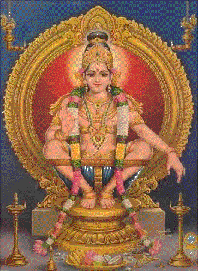 Hinduism is a religion with various Gods and Goddesses. According to Hinduism, three Gods rule the world. Brahma: the creator; Vishnu: the preserver and Shiva: the destroyer. These three Lords have consorts and they are goddesses too. Consort of Brahma is Sarasvati; goddess of learning. Vishnu's consort is Lakshmi; goddess of wealth and prosperity. Shiva's consort is Parvati who is worshipped as Kali or Durga.
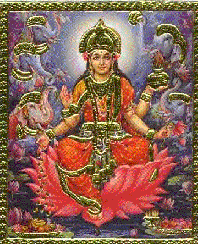 . .  Besides these there are a number of other Gods and Goddesses. To name a few, there is Ganesh, who has an elephant's head and he is also a son of Shiva and Parvati; Hanuman, who is an ape; Surya Lord of sun; Ganga Ma, Goddess of river Ganges; Samundra, Lord of the sea; Indra, king of the Gods; Prithvi, Goddess of earth; Shakti, Goddess of strength.
"Lord Ganesheya"
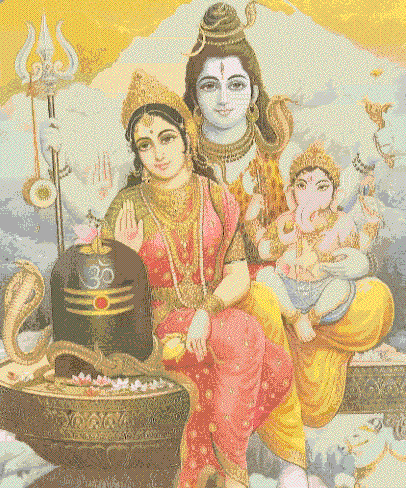 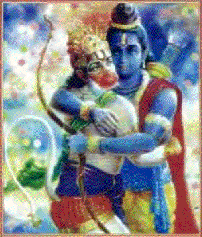 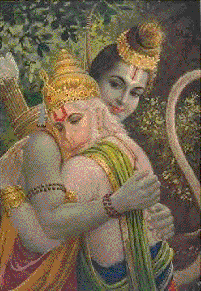 Some gods have more than one name. Shiva is also known as Shankar, Mahadev, Natraj, Mahesh amongst others. His worshippers also worship images of bull called Nandi, who was Shiva's carrier and a unique stone design connected to Shiva called the Shiva-Lingham. Ganesh is also called Ganpati. Lord Vishnu went about preserving the world by incarnating 10 times in human forms in times of crisis, and in his every appearance he had a different form which are also worshipped as Gods. Among his appearances, he appeared as Rama, Krishna, Narsimha, Parsuram and Buddha. Krishna also has different names, Gopal; Kishan; Shyam and other names. There are also Gods who can change their forms, such as Parvati who can change into Kali or Durga.
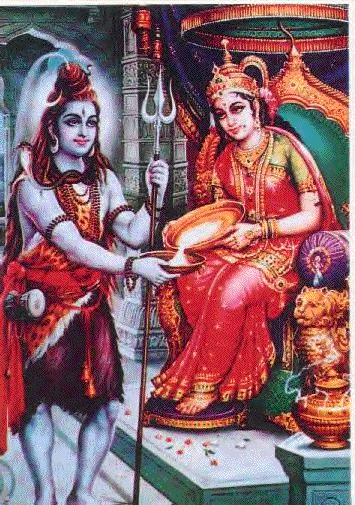 Not all of these Gods are worshipped by all Hindus, with some Hindus worshipping specific Gods or Goddesses, and some of these have predominance in some regions. Hindus also worship Gods according to their personal needs; those engaged in wrestling, body building and other physical sports worship Hanuman, who in Hindu legends was an ape with lot of physical strength; and those in business worship Lakshmi, Goddess of wealth.
Though these Hindus worship different idols, there are many Hindus who believe in one God and perceive in these different Gods and Goddesses as different images of the same one God. According to their beliefs, idolatry is the wrong interpretation of Hinduism.
A unique and all-encompassing characteristic of Hinduism is that one devotee may be worshipping Ganesha while a friend worships Siva or Vishnu or Kali, yet both honor the other's choice and feel no sense of conflict. The Hindu religion brings us the gift of tolerance that allows for different stages of worship, different and personal expressions of devotion and even different Gods to guide our life on this earth. You will thus find Hindu temples for different Gods and Goddesses in near proximity to each other. Indeed, you will find places of worship for many different faiths in close proximity to each other. About 80% of the population are Hindus, thus by far the most common religion in India.

*Please send all
complaints to Wizard *
with very limited knowledge,
but trying :).."Confuscious says--OM"..
The Dedicated Website of Brahma Satya Reiki
*GO TO*
|
|
*A dynamic Resource*
|
The Dedicated Website
of Brahma Satya Reiki
|
|
MAA Trupta Raga Rajeshwari | home
MAA Trupta Raga Rajeshwari | Durga One | Durga Seventeen | Durga Eighteen | Brahma Satya Reiki By Deepak Hardikar | GAYATRI MANTRA | About Us | The Abode of Shiva | Calendar | 3rd Grid Expansion Members | Newsletter | Brahma Satya Reiki Meditations | Contact Us | 3rd Expansion Grid Members | Hinduisim-The Essence of India | MAA's Learning | MAA Trupta Raga Rajeshwari's Peacock | MAA's Peacock in Wonderland | MAA'S Devi Peacock Feather Friends | MAA Trupta Raga Rajeshwari Devi Swan | Swan Images | MAA'S Journey's the Lands and Waters | Puja Downloads | Prayers to Ganeshaya | Ganeshaya Images | Lord Ganesheya | Krishna | Ganesha Upanishad | Sarasawti, Saravati | Shiva
MAA's Learning
|

